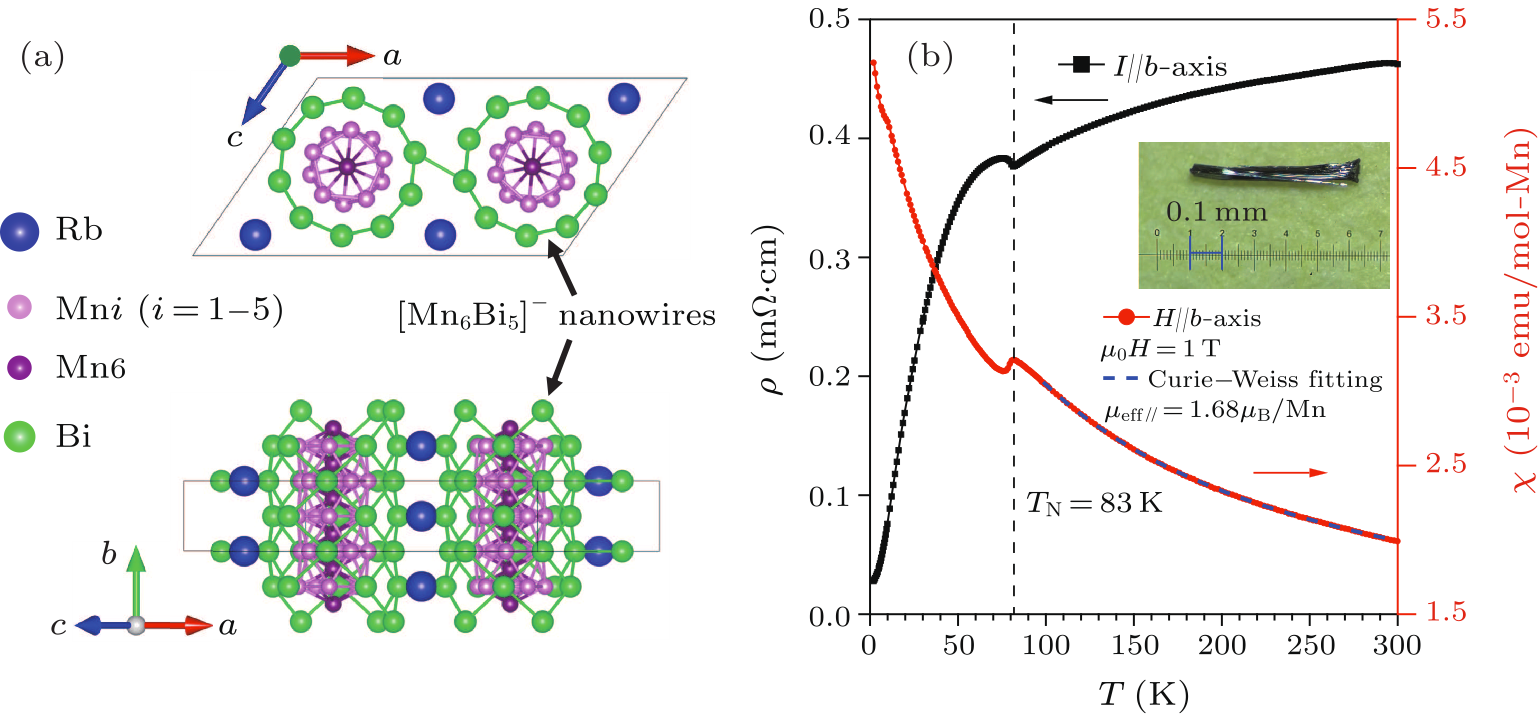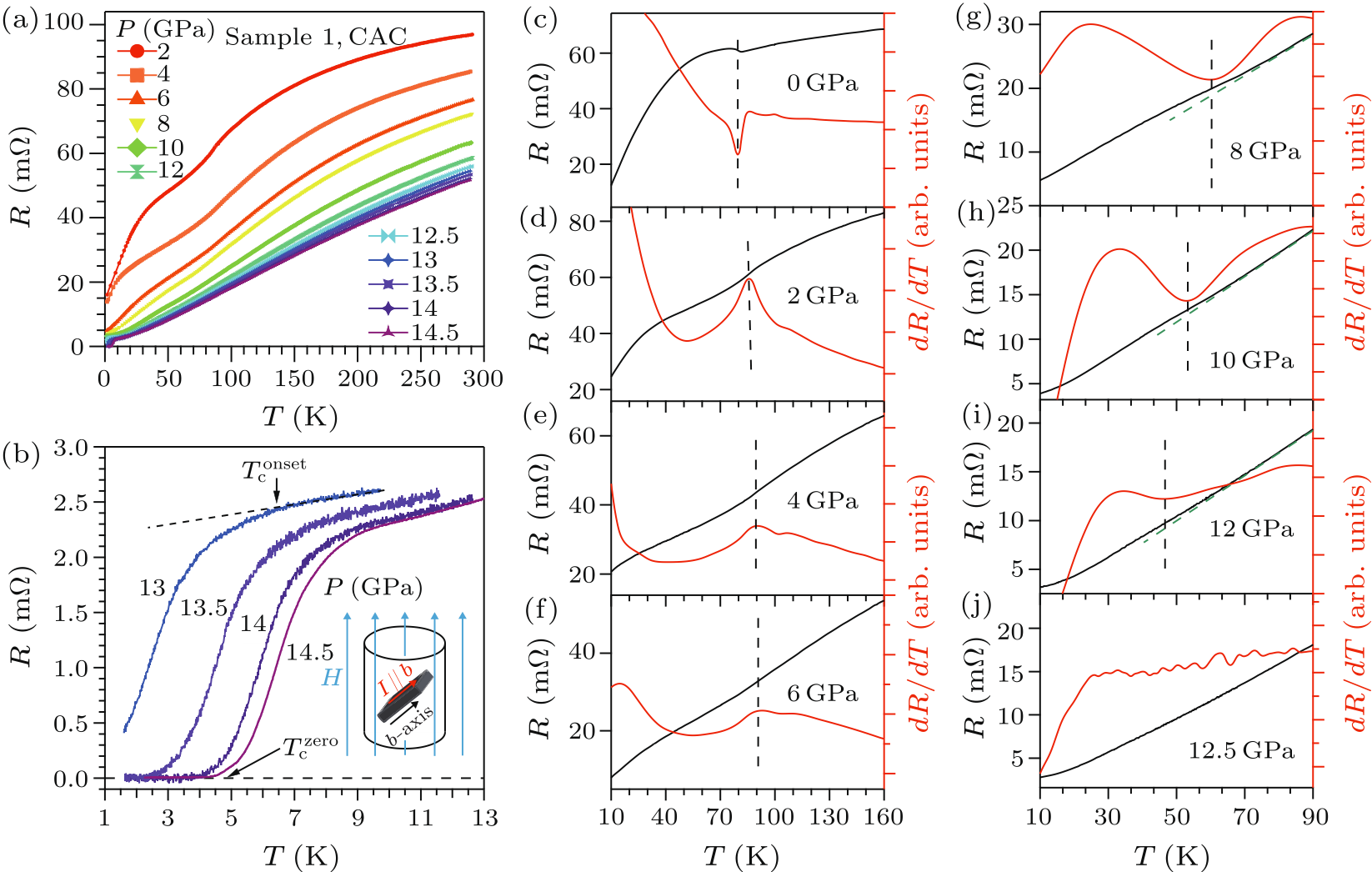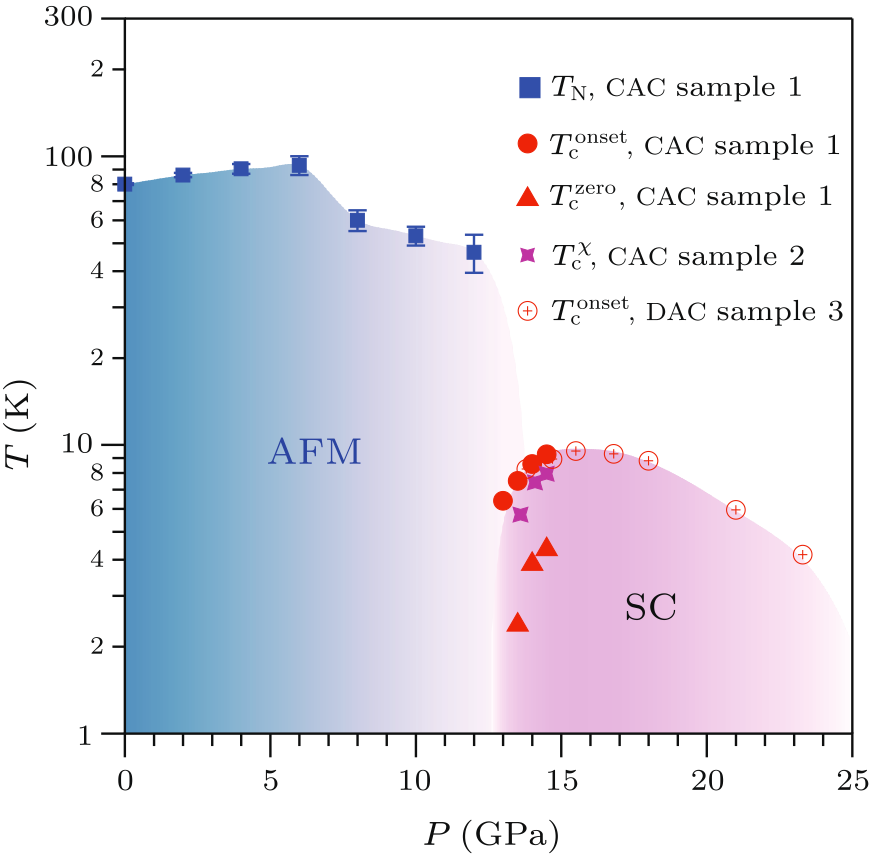




Fig. 1. (a) Crystal structure of RbMn$_{6}$Bi$_{5}$. (b) Temperature dependence of the resistivity and magnetic susceptibility along the rod direction of RbMn$_{6}$Bi$_{5}$ crystal at AP. The $T_{\rm N}$ shows the antiferromagnetic transition temperature. The Curie–Weiss fitting is shown by the broken line. Inset of (b) shows a picture of the RbMn$_{6}$Bi$_{5}$ crystal.

Fig. 2. (a) Electrical resistance of RbMn$_{6}$Bi$_{5}$ (sample 1) under various pressures measured in a CAC. (b) The low-temperature $R(T)$ data highlighting the superconducting transition. (c)–(j) The $R(T)$ and the corresponding $dR/dT$ curve at each pressure showing the evolution of the antiferromagnetic transition.

Fig. 3. (a)–(c) $R(T)$ under different magnetic fields at 13.5, 14 and 14.5 GPa. (d) The temperature dependences of $\mu_{0}H_{\rm c2}(T)$ fitted by the Ginzburg–Landau (G-L) equation, $\mu_{0}H_{\rm c2}(T)=\mu_{0}H_{\rm c2}(0)[1-(T/T_{\rm c})^{2}]/[1+(T/T_{\rm c})^{2}]$ and the two-band model. (e) The ac magnetic susceptibility $\chi^{\prime}(T)$ of RbMn$_{6}$Bi$_{5}$ crystal (sample 2) and a piece of Pb with similar volume. (f) The low-temperature $R(T)$ data of RbMn$_{6}$Bi$_{5}$ crystal (sample 3) measured with a DAC. The curves in (e) and (f) have been shifted vertically for clarity.

Fig. 4. $T$–$P$ phase diagram of RbMn$_{6}$Bi$_{5}$. The AFM and SC refers to the antiferromagnetic and the superconducting phases, respectively.
| [1] | Bednorz J G and Müller K A 1986 Z. Phys. B: Condens. Matter 64 189 | Possible highT c superconductivity in the Ba?La?Cu?O system
| [2] | Kamihara Y, Hiramatsu H, Hirano M, Kawamura R, Yanagi H, Kamiya T, and Hosono H 2006 J. Am. Chem. Soc. 128 10012 | Iron-Based Layered Superconductor: LaOFeP
| [3] | Kamihara Y, Watanabe T, Hirano M, and Hosono H 2008 J. Am. Chem. Soc. 130 3296 | Iron-Based Layered Superconductor La[O1- x F x ]FeAs ( x = 0.05−0.12) with Tc = 26 K
| [4] | Cheng J G, Matsubayashi K, Wu W, Sun J P, Lin F K, Luo J L, and Uwatoko Y 2015 Phys. Rev. Lett. 114 117001 | Pressure Induced Superconductivity on the border of Magnetic Order in MnP
| [5] | Liu Z Y, Dong Q X, Yang P T, Shan P F, Wang B S, Sun J P, Dun Z L, Uwatoko Y, Chen G F, Dong X L, Zhao Z X, and Cheng J G 2022 Phys. Rev. Lett. 128 187001 | Pressure-Induced Superconductivity up to 9 K in the Quasi-One-Dimensional
| [6] | Gegenwart P, Si Q, and Steglich F 2008 Nat. Phys. 4 186 | Quantum criticality in heavy-fermion metals
| [7] | Stewart G R 2011 Rev. Mod. Phys. 83 1589 | Superconductivity in iron compounds
| [8] | Keimer B, Kivelson S A, Norman M R, Uchida S, and Zaanen J 2015 Nature 518 179 | From quantum matter to high-temperature superconductivity in copper oxides
| [9] | Bao J K, Tang Z T, Jung H J, Liu J Y, Liu Y, Li L, Li Y K, Xu Z A, Feng C M, Chen H, Chung D Y, Dravid V P, Cao G H, and Kanatzidis M G 2018 J. Am. Chem. Soc. 140 4391 | Unique [Mn6 Bi5 ]− Nanowires in KMn6 Bi5 : A Quasi-One-Dimensional Antiferromagnetic Metal
| [10] | Chen L, Zhao L, Qiu X, Zhang Q, Liu K, Lin Q, and Wang G 2021 Inorg. Chem. 60 12941 | Quasi-One-Dimensional Structure and Possible Helical Antiferromagnetism of RbMn6 Bi5
| [11] | Zhou Y, Chen L, Wang G, Wang Y X, Wang Z C, Chai C C, Guo Z N, Hu J P, and Chen X L 2022 Chin. Phys. Lett. 39 047401 | A New Superconductor Parent Compound NaMn6 Bi5 with Quasi-One-Dimensional Structure and Lower Antiferromagnetic-Like Transition Temperatures
| [12] | Matsuda M, Ye F, Dissanayake S E, Cheng J G, Chi S, Ma J, Zhou H D, Yan J Q, Kasamatsu S, Sugino O, Kato T, Matsubayashi K, Okada T, and Uwatoko Y 2016 Phys. Rev. B 93 100405(R) | Pressure dependence of the magnetic ground states in MnP
| [13] | Taddei K M, Xing G, Sun J, Fu Y, Li Y, Zheng Q, Sefat A S, Singh D J, and de la Cruz C 2018 Phys. Rev. Lett. 121 187002 | Frustrated Structural Instability in Superconducting Quasi-One-Dimensional
| [14] | Cuono G, Forte F, Romano A, Ming X, Luo J, Autieri C, and Noce C 2021 Phys. Rev. Mater. 5 064402 | Tuning interchain ferromagnetic instability in ternary arsenides by chemical pressure and uniaxial strain
| [15] | Bao J K, Liu J Y, Ma C W, Meng Z H, Tang Z T, Sun Y L, Zhai H F, Jiang H, Bai H, Feng C M, Xu Z A, and Cao G H 2015 Phys. Rev. X 5 011013 | Superconductivity in Quasi-One-Dimensional with Significant Electron Correlations
| [16] | Uwatoko Y, Matsubayashi K, Matsumoto T, Aso N, Nishi M, Fujiwara T, Hedo M, Tabata S, Takagi K, Tado M, and Kagi H 2008 Rev. High Press. Sci. Technol. 18 230 | Development of Palm Cubic Anvil Apparatus for Low Temperature Physics
| [17] | Cheng J G, Matsubayashi K, Nagasaki S, Hisada A, Hirayama T, Hedo M, Kagi H, and Uwatoko Y 2014 Rev. Sci. Instrum. 85 093907 | Integrated-fin gasket for palm cubic-anvil high pressure apparatus
| [18] | Tinkham M 1963 Phys. Rev. 129 2413 | Effect of Fluxoid Quantization on Transitions of Superconducting Films
| [19] | Clogston A M 1962 Phys. Rev. Lett. 9 266 | Upper Limit for the Critical Field in Hard Superconductors
| [20] | Lee P A, Nagaosa N, and Wen X G 2006 Rev. Mod. Phys. 78 17 | Doping a Mott insulator: Physics of high-temperature superconductivity
| [21] | Gurevich A 2003 Phys. Rev. B 67 184515 | Enhancement of the upper critical field by nonmagnetic impurities in dirty two-gap superconductors
| [22] | Hunte F, Jaroszynski J, Gurevich A, Larbalestier D C, Jin R, Sefat A S, McGuire M A, Sales B C, Christen D K, and Mandrus D 2008 Nature 453 903 | Two-band superconductivity in LaFeAsO0.89F0.11 at very high magnetic fields
| [23] | Chen K Y, Wang N N, Yin Q W, Gu Y H, Jiang K, Tu Z J, Gong C S, Uwatoko Y, Sun J P, Lei H C, Hu J P, and Cheng J G 2021 Phys. Rev. Lett. 126 247001 | Double Superconducting Dome and Triple Enhancement of in the Kagome Superconductor under High Pressure
| [24] | Hung T L, Huang C H, Deng L Z, Ou M N, Chen Y Y, Wu M K, Huyan S Y, Chu C W, Chen P J, and Lee T K 2021 Nat. Commun. 12 5436 | Pressure induced superconductivity in MnSe
| [25] | Norman M 2015 Physics 8 24 | Superconductivity with a Twist
| [26] | Wu X, Yang F, Le C, Fan H, and Hu J 2015 Phys. Rev. B 92 104511 | Triplet -wave pairing in quasi-one-dimensional superconductors
| [27] | Yang J, Luo J, Yi C, Shi Y, Zhou Y, and Zheng G Q 2021 Sci. Adv. 7 eabl4432 | Spin-triplet superconductivity in K2 Cr3 As3